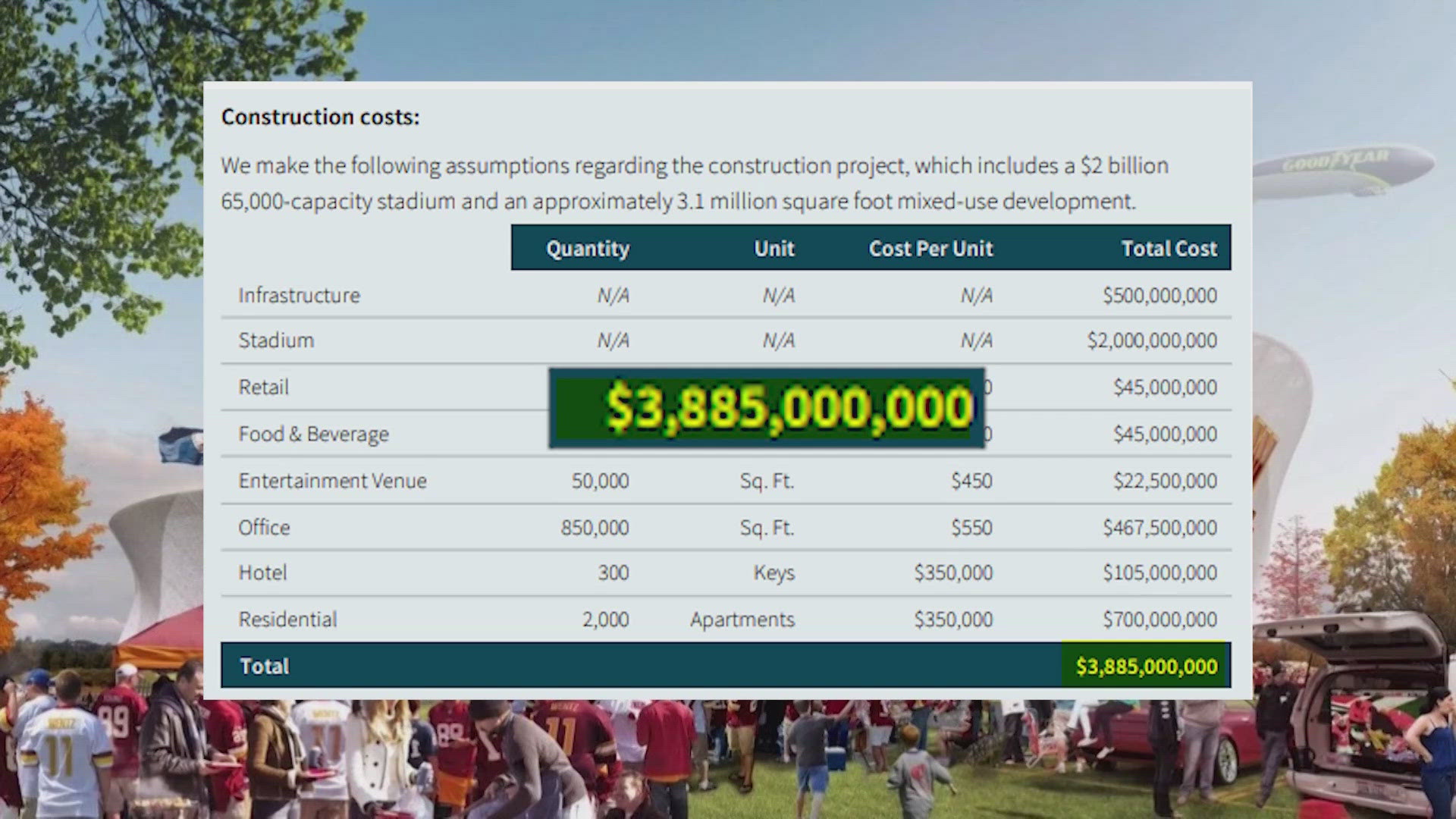WASHINGTON — Three months after it was completed, DC Government released a portion of an economic impact study of professional sports in the District. But city officials are still withholding a key portion of that study: How DC would pay for a new football stadium for the Washington Commanders.
According to data obtained from D.C.’s Chief Financial Officer, by 2030 the District is predicted to be more than $1.7 billion in debt. Which includes that $520 million the city just shelled out for renovations at Capitol One. Combined with other projects, that puts D.C. smack up against D.C.’s limit on debt based on D.C. law.
D.C.’s release of the study comes 27 days after WUSA9 filed a legal request under the Freedom of Information Act to obtain it. It was completed in mid-March according to one of the study’s authors, former DC Councilmember Jack Evans.
Titled “Economic Impact of the District’s Major Sports Teams & Facilities” the report paints a rosy picture of the economic windfall a new football stadium would bring to the District. D.C. is competing with Maryland and Virginia to be the home of the new Commanders stadium.
The study projects a one time economic impact of $2.29 billion during the construction phase in the District, with a $1.26 billion recurring annual economic impact yearly after that. It assumes 70 non football related events per year, although does not specify inclusion of a dome.
“DC is the Sports Capital. We know how important sports are to our city’s economy and culture,” said Mayor Muriel Bowser in a prepared statement which was emailed to WUSA9 Thursday morning. “They create jobs, generate tax revenue, and spur economic development. But sports also create a lot of pride in our city, they bring people together, and we look forward to continuing to support our teams in ways that benefit our city and residents and help knock DC’s Comeback out of the park.”
Mayor Bowser did not immediately make herself available for questions about the study to WUSA9.
The case studies the projections are based off included a The Battery, a mixed use retail development built as part of the Atlanta Braves Truist Park; Hollywood Park, a domed football stadium built as part of the SoFi Stadium development in Los Angeles, and Downtown Commons, which is part of the Sacramento Kings basketball area complex.
D.C. still does not have long-term control of the RFK site, which is where a proposed Commanders stadium would be built in the District. But a bill in Congress which would give DC total control of the federally owned land has passed the House of Representatives, and is now awaiting approval in the Senate.
It is clear a number of D.C. leaders, including Mayor Muriel Bowser, are planning to make a significant push to lure Washington’s football team back to the District, from its current home in Landover, Maryland.
Among the study’s key findings:
- Major sports are a significant export of the District’s economy. The study found the arts, entertainment, and recreation industry contributed $5 billion to the District’s $165 billion economy in 2022.
- The District's major sports attracted 7.4 million visitors in 2023, with 88% being non-District residents.
- The District’s major sports teams and facilities have catalyzed neighborhood prosperity. According to the study, commercial real estate development near the District’s sports facilities outpaced District-wide developments in the years following each facility’s opening and commercial real estate pricing near the District’s sports facilities command significant premiums over District-wide averages.
Some, including Councilmember Charles Allen, have questioned the impartiality of the two consulting firms paid around $400,000 to conduct the research.
Evans, in particular, has called for the return of the Commanders to D.C. for years, and spearheaded the DC Government’s deal to borrow more than $500 million dollars to build Nationals Park in 2006 while he was still on the council.
Financially, the investment in Nationals Park has worked out very well for D.C.’s economy, which is referenced in the report.
“We make the following assumptions regarding the construction project,” the authors write, “which includes a $2 billion 65,000-capacity stadium and an approximately 3.1 million square foot mixed-use development.”
The study’s economic impact projections are based on a total construction cost price tag of $3.8 billion, which includes the infrastructure, stadium, an entertainment venue, office space, hotel and residential housing.
Price tags for NFL stadiums can vary wildly.
SOFI Stadium, a 70,000-seat stadium opened in 2020, cost an estimated $4.9 billion. That same year Allegiant Stadium in Las Vegas opened at a cost of $1.9 billion.
The Buffalo Bills' new stadium is scheduled to open in 2026 at a cost of $1.7 billion.
The Tennessee Titans' new stadium, which includes a dome, is projected to cost $2.1 billion and open in 2027. In that case, $1.26 billion of construction costs are being subsidized by the public.
In Chicago, a proposal for a domed stadium is projected in the neighborhood of $3 billion, not that’s not including development of the surrounding area.
Do you have a news tip on this story or any other story? We want to hear from you. Tell us about it by emailing newstips@wusa9.com.
MORE WAYS TO GET WUSA9
DOWNLOAD THE WUSA9 APP
Apple App Store: WUSA9 News on Apple
Google Play Store: WUSA9 News on Android
HOW TO ADD THE FREE WUSA9+ APP TO YOUR STREAMING DEVICE
ROKU: add the channel from the ROKU store or by searching for WUSA9.
For both Apple TV and Fire TV, search for "WUSA9" to find the free app to add to your account. Another option for Fire TV is to have the app delivered directly to your Fire TV through Amazon.
SIGN UP TO RECEIVE WUSA9 NEWSLETTER
Subscribe to our daily WUSA9 Newsletter for top stories from WUSA9 curated daily just for you. Get content and information right now for can’t-miss stories, Commanders content, weather, and more delivered right to your inbox.

